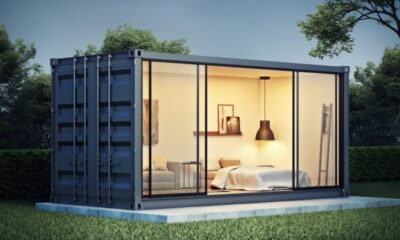Living In A Shipping Containers: The House Of The Future
Shipping containers have become an easy and inexpensive way to build prefab homes. But what is it like to live in a container? Can they stop being a temporary housing solution to become something permanent?
What is it like to live in a container?
Proponents of expandable container houses homes say the speed of installation, huge material cost savings, and being able to easily reuse or transport these homes to a new location make these homes a serious, permanent housing option.
Everyone (designers, architects, engineers, etc.) is wondering if these versatile containers can play a much bigger role in alleviating the housing crisis.
But what is it like to live in a huge steel box? Do you remember Adam? He points out that his container is cozy: it has a living room, bathroom, and balcony. Insulated panels and radiators help keep the place warm during the winter. Privacy hasn’t been a problem either. In fact, he says the place is too quiet.
Containers offer more privacy and a good location at a lower cost. However, the young student admits that container houses are a bit small for two people. Therefore, they are a more functional space for single people.
We have to change the idea that living in a container is bad
The company Tempohousing was in charge of materializing the construction of Wenckehof. This company has also created other large projects with containers such as parks and a hotel for temporary workers. Most of your clients want to get basic, transitional housing at the lowest possible cost. Containers are a cost-effective solution.
The truth is that most people think that a container is not a good place to live. They continue to think that it is something temporary, but the truth is that a thousand things can be done with these metal structures without raising costs too much. Little by little this conception will change. Container homes may be much more in demand in the not-too-distant future.
Mixed opinions
As expected, this type of housing also has its detractors. Not everyone is convinced that shipping containers are the housing of the future. Containers modified to be homes “doesn’t make sense.” He says that the cost savings disappear when you try to modify the basic structure of the containers. For example, if the idea is to merge them, it will cost much more.
Apparently the only way to make these structures cheaper is to simply stack them on top of each other, without using other construction methods. In the opposite case, it would be necessary to add other materials and substructures to give it more stability.
The impression that expandable container homes cannot have an interesting aesthetic design and that they are just transitional homes is something that frustrates many designers and architects. However, there are some who are determined to prove otherwise.
An option not to be ignored
There is no denying that people continue to see containers as transitory places. Therefore, it is difficult to imagine that in the future they will be considered as serious and permanent housing projects. However, the advantages of converting these containers into homes are too good to ignore that there is such a great possibility.
Sustainability, cost and easy change of location are some of the benefits. The truth is that this can be a viable solution to the housing crisis facing many countries today.


Your comment is awaiting moderation.
buy estradiol 2mg generic – purchase ginette 35 generic order arimidex 1mg online cheap